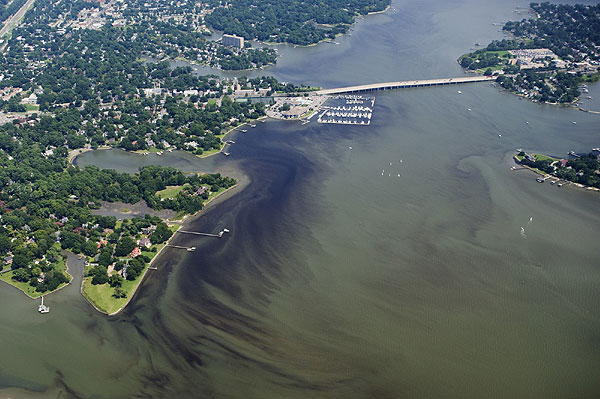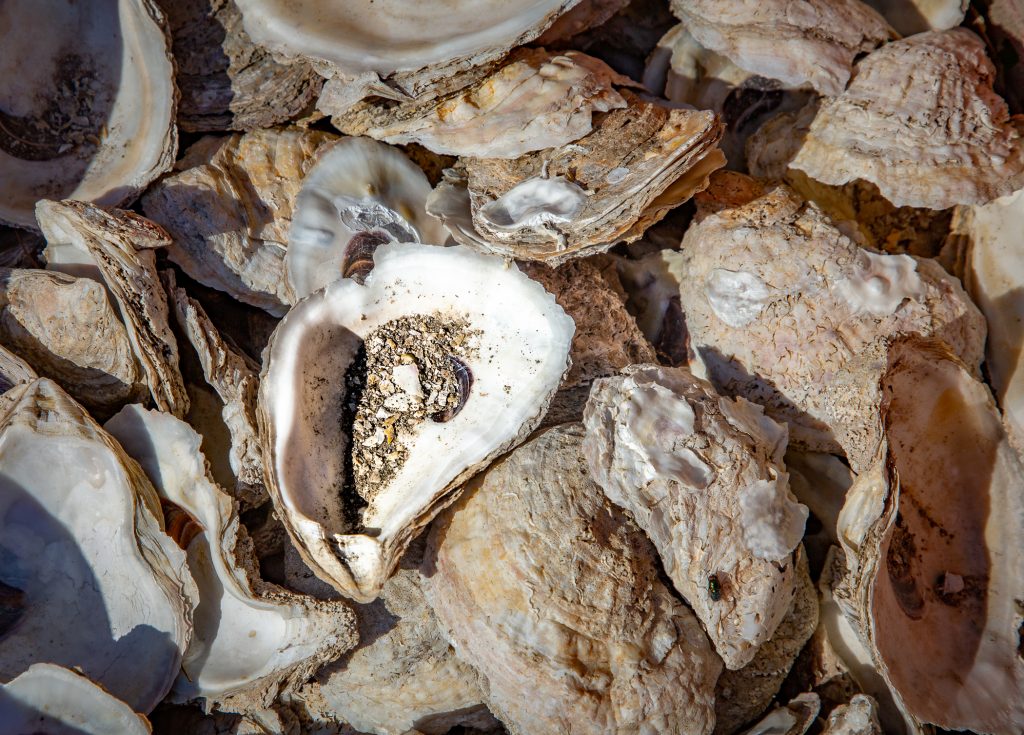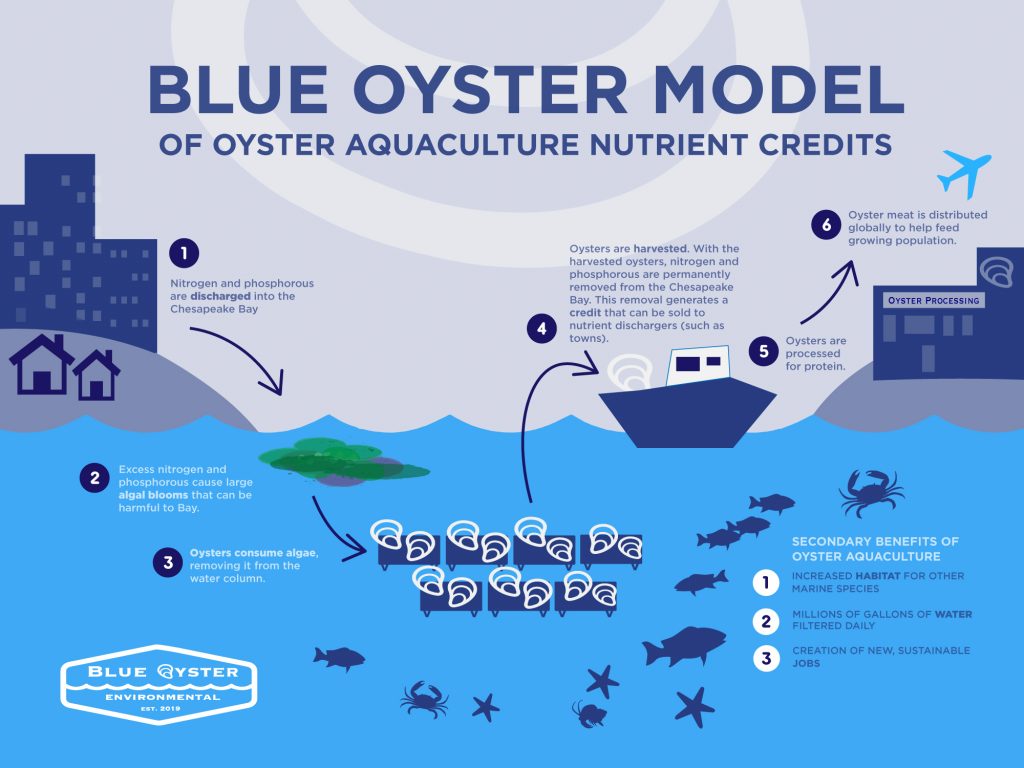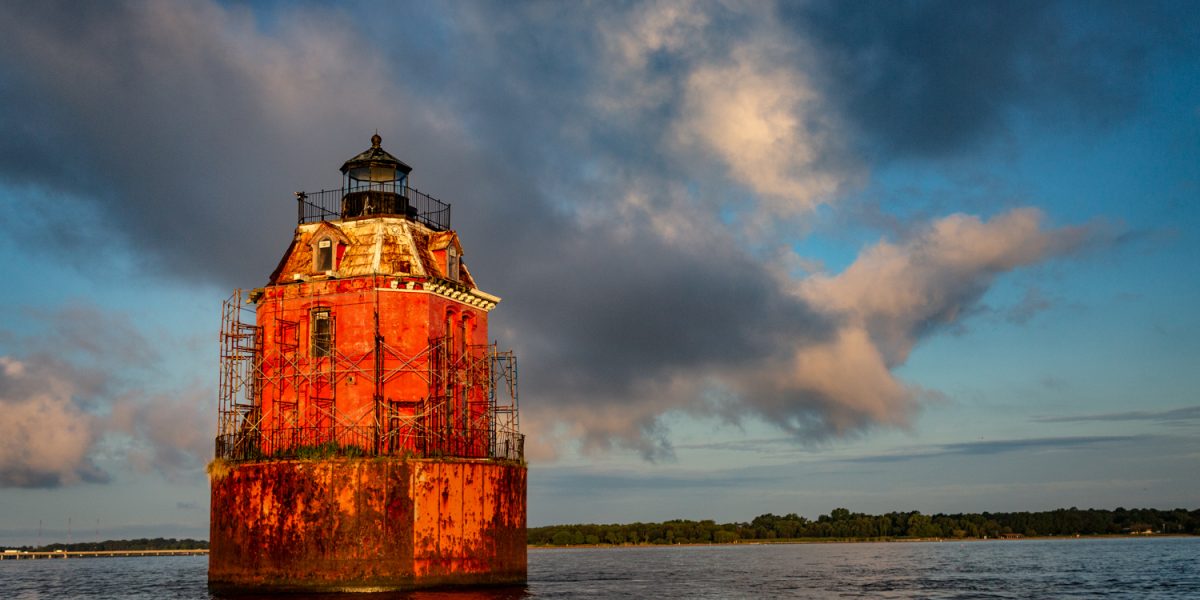Our 2021 Ecoprint calendar, Protecting the Natural Beauty of the Chesapeake Bay, has given us the opportunity to work with 13 different organizations, all dedicated to helping solve the environmental challenges in this important ecological hub. March features Blue Oyster Environmental, a pioneering oyster aquaculture company on Maryland’s Eastern Shore.
The Chesapeake Bay is an amazing gem known the world over for its impeccable beauty and the diversity of its aquatic life. But that’s not the full picture. The truth is, amidst all the “beauty,” the bay has been experiencing enormous challenges since the mid-20th century. One of these challenges is a decline in crab, fish, and oyster populations due to algal blooms.

Algal blooms like the one pictured above occur when stormwater and agricultural runoff reach the Chesapeake Bay and its tributaries. The excess nitrogen and phosphorus cause algae to multiply rapidly and, when they die off, create an oxygen depleted “dead zone.” These zones can make it hard for fish and other aquatic life to receive the oxygen they need to survive. They can also block sunlight from reaching submerged aquatic vegetation, hindering its growth.
The problem has become so severe that organizations, such as Blue Oyster Environmental, are stepping in to address the situation. Here are just a few of the initiatives that Blue Oyster Environmental is tackling to revive the oyster population, improve the environment, and revitalize the culture that surrounds the Chesapeake Bay watershed.

Facilitating an increase in oyster farming
Due to Blue Oyster Environmental’s campaigns, oyster farming has increased 20 times over since 2012, according to a report by the Maryland Department of Natural Resources. This resurgence is a positive trend, as oyster aquaculture is a sustainable and environmentally beneficial option for food production.
Reducing algal blooms
Pollutants like algal blooms have significantly contributed to the decline of aquatic life in the Chesapeake Bay. Oysters are extremely helpful in removing water pollutants in the ecosystem. They consume phytoplankton, algae, nitrogen, and phosphorus from the water and can filter up to 50 gallons of water a day. The increase in oyster farming means that water filtration is high, resulting in algae bloom reduction.
Creating sustainable jobs for watermen
The Chesapeake Bay has, over the years, provided watermen with sustainable income from oystering, fishing, and crabbing. Despite the recent decline in aquatic life, the area is slowly regaining its footing, in no small part thanks to work done by Blue Oyster Environmental. The significant increase in oyster population means that by 2030, there will be a sustainable income stream for watermen.

Blue Oyster Environmental is changing the future of the Chesapeake Bay through oyster aquaculture and brokering nitrogen credits as part of Maryland’s water quality trading program. With their focus on business, environment and culture, there is hope that the oyster population—and with it the surrounding watershed communities—will soon be thriving once again.
Sustainably,
Bobby Firestein
Blue Oyster Environmental
Blue Oyster Lifestyle is a brand that has a mission of supporting and growing the oyster aquaculture industry and preserving the waterman culture and lifestyle. A portion of each dollar is used to purchase nutrient credits directly from oyster farmers so they can continue to grow more oysters and provide an essential service to the Chesapeake Bay.
History & Vision
Blue Oyster Environmental, founded in 2019, was started to reestablish the oyster population in Chesapeake Bay’s ecosystem. For nearly 200 years, the Eastern oyster has helped provide an economic base in the area. Over the years, however, the oyster population has drastically diminished along with the ecology and economy they once supported.
It is estimated that the wild oyster population has decreased from 600 million in 1999 to 300 million in 2018. The 50% population decrease in less than 20 years has endangered the once historic fishing industry. To combat the decreasing oyster population, strict regulations were put in place, which have posed many challenges for the crabbing, oyster operations, and fishing industries.
Blue Oyster Environmental is committed to reestablishing the Eastern oyster as the keystone species of the Chesapeake Bay ecosystem. As the oyster industry thrives again, so too will the working waterfront communities that have made up the heart and soul of the Bay for generations.

